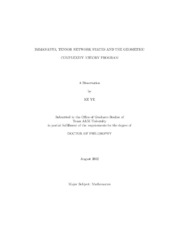| dc.description.abstract | We study the geometry of immanants, which are polynomials on n^2 variables that are defined by irreducible representations of the symmetric group Sn. We compute stabilizers of immanants in most cases by computing Lie algebras of stabilizers of immanants. We also study tensor network states, which are special tensors defined by contractions. We answer a question about tensor network states asked by Grasedyck. Both immanants and tensor network states are related to the Geometric Complexity Theory program, in which one attempts to use representation theory and algebraic geometry to solve an algebraic analogue of the P versus N P problem.
We introduce the Geometric Complexity Theory (GCT) program in Section one and we introduce the background for the study of immanants and tensor network states. We also explain the relation between the study of immanants and tensor network states and the GCT program.
Mathematical preliminaries for this dissertation are in Section two, including multilinear algebra, representation theory, and complex algebraic geometry.
In Section three, we first give a description of immanants as trivial (SL(E) x SL(F )) ><| delta(Sn)-modules contained in the space S^n(E X F ) of polynomials of degree n on the vector space E X F , where E and F are n dimensional complex vectorspaces equipped with fixed bases and the action of Sn on E (resp. F ) is induced by permuting elements in the basis of E (resp. F ). Then we prove that the stabilizer of an immanant for any non-symmetric partition is T (GL(E) x GL(F )) ><| delta(Sn) ><| Z2, where T (GL(E) x GL(F )) is the group of pairs of n x n diagonal matrices with the product of determinants equal to 1, delta(Sn) is the diagonal subgroup of Sn x Sn. We also prove that the identity component of the stabilizer of any immanant is T (GL(E) x GL(F )).
In Section four, we prove that the set of tensor network states associated to a triangle is not Zariski closed and we give two reductions of tensor network states from complicated cases to simple cases.
In Section five, we calculate the dimension of the tangent space and weight zero subspace of the second osculating space of GL_(n^2) .[perm_n] at the point [perm_n] and determine the Sn x Sn-module structure of this space. We also determine some lines on the hyper-surface determined by the permanent polynomial.
In Section six, we give a summary of this dissertation. | en |


